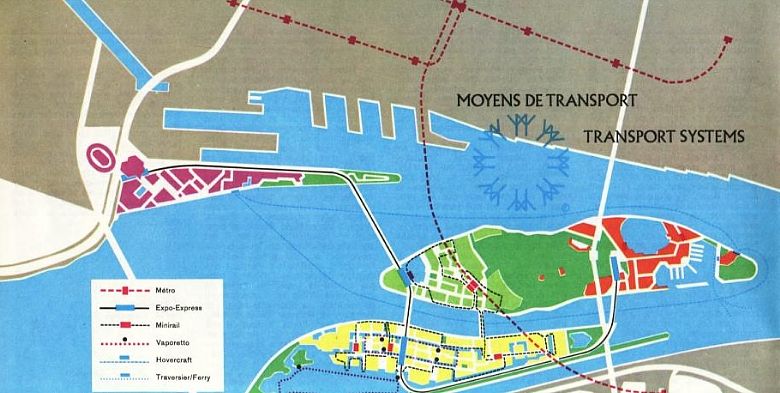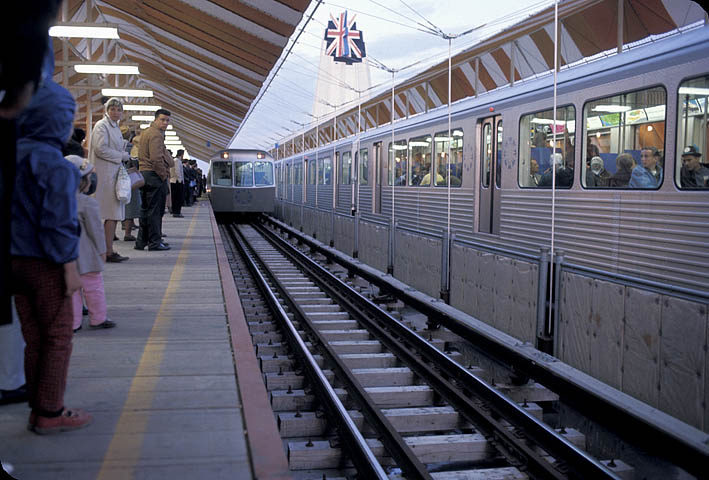Expo 67’s 40th anniversary has passed, but there’s one aspect of the world fair that I find strangely overlooked: its transportation system. While the Minirail and pedicabs moved people around the Expo site, more serious transit links were needed to get them to and from Notre Dame and St. Helen’s islands.
That’s where the metro, Expo Express and hovercrafts came into play. Hovercrafts were used to speed people between the South Shore, La Ronde and the Cité du Havre. The metro’s yellow line was built between Montreal and Longueuil because it offered a stop on St. Helen’s Island, right in the middle of the Expo action.
The Expo Express, meanwhile, was an above-ground metro line that ran for 5.7 kilometres between La Ronde and La Cité du Havre, with stops at four stations along the way. In terms of technology, it was essentially the same as the Toronto subway, except for one important difference: it was completely automated. Trains ran every five minutes and carried 1,000 passengers each.
After Expo ended, Expo Express was completely dismantled and the hovercrafts were discarded. It might not seem like such a big deal: they were needed for a fair and, when that fair ended, they were discarded. So what?
Well, it strikes me as awfully short-sighted to have permanently scrapped such an efficient public transportation system. Whereas Expo sites in other cities were intensively reused — after Expo 86, Vancouver redeveloped its fair site as a new residential district with room for 20,000 people — Montreal didn’t do much with its own. Today, we have a casino, a racetrack, a beach and a nice park, but that’s about it.

Notre Dame Island in the foreground, with Expo Express running through the centre
In alternate-universe Montreal, the park on St. Helen’s Island would exist much as it does today, as a large park, but Notre Dame Island would have been redeveloped into a unique, car-free, high-density mixed-use neighbourhood, a modern-day Venice with apartment buildings, shops and offices lining pedestrian streets and canals. Residents and visitors could park their cars at a central parking garage near the Pont de la Concorde and the present-day casino.
Something similar would have been built around Habitat 67 at the Cité du Havre. It would have been a highly desirable place to live, with access to the water and great views of the downtown skyline, river and mountain.
Finally, Expo Express would have been maintained and even extended north, linking these two new developments with the downtown core. Montreal would be renowned for its distinctive, transit-oriented waterfront communities, a model for sustainable development around the world.
Now that would have been a legacy worthy of Expo 67.




7 comments
Since I always went during summer, I never noticed how Toronto and New York’s subways were dealing with the snow. That’s my point, how does an outside rail subway like the Expo Express would have delt with a 40cm snow fall?
Still would have been a good idea to keep it maybe for tourist season. I’m also quite happy with the vision of the carless neigborhood that would have been impressive indead and I’m quite surprise to have a discussion on Montreal vision on this blog.
Indeed, there were plans to continue with Habitat housing along Cite du Havre with Moshe Safde having developed the master plan. Unfortunately, as is the case with many projects in Montreal over the last 40 or so years, bureaucratic bungaling got in the way.
BruB, Toronto’s subway system– like most Toronto transport options– can’t handle heavy snowfall. In rare cases when heavy snow does fall on that city, the east half of the bloor-danforth line (which bridges the don valley) is particularly vulnerable to stalling, as are portions of the yonge-university-spadina line. You’re right. It would be no small feat to keep an outdoor line operational in Montreal. These ideas are fun, but I think at the end of the day, I’d rather see all that energy and budgeting channeled into the core system.
Exactly. Not to mention, this whole ecological movement just got its legs last year, and it’s mainly fueled by companies who realised that they can make a ton of money by cashing in on this “green” stuff.
This experiment however looks interesting:
http://www.popularmechanics.com/science/earth/4239381.html?page=1
Whoa there! Some of us have been fighting for bicycle paths and more public transport, fewer cars and traffic-calming measures for a good 30 years – we think of Bicycle Bob Silverman and the late Claire Morrissette. Sure some businesses have jumped on the “green” bandwagon as the extent of environmental damage becomes obvious to just about everyone, but they certainly weren’t at the inception of the urban ecology movement.
Couldn’t the Expo metro line have been covered, as there weren’t any buildings overhead? That would have been cheaper than tunnelling.
If not, the same problems will arise with a tram system, but it is still a better transport alternative than buses, not to mention the absurdity of private cars in a densely-populated urban area. (The car was a wonderful invention, but has been misused in an urban context).
Trams were found in Montreal, Ottawa and Quebec City (they feature prominently in the film “Les Plouffe”) – the latter had to cope not only with long, cold, snowy winters but also with the steep incline between lower and upper town.
It is a dreadful missed opportunity, after spending so much money on it.
I don’t think the train itself so much as the automation would suffer with snow. The automated Skytrain in Vancouver has sensors to detect if someone jumps in front of a train, but these don’t work if there is snow in the air so they have to switch to manual operation for safety. But being an automated system they don’t have as many trained drivers as there are trains, so they actually have to decrease service when they need it most. And when I say “snow in the air”, I’m saying anytime it snows at all.
I agree. Implementing an outdoor express route in Montreal would be difficult with the brutal winters, however, if it were covered or travelled only short distances outside, the tracks could be heated to avoid ice and snow. Montreal’s transport system is much more effective than Toronto’s (as we all know by the ridiculous wait times for street cars in Toronto) including the less than comprehensive subway system. At least Montreal is a much more compact city that has more access to subways and rapid transit than Toronto.